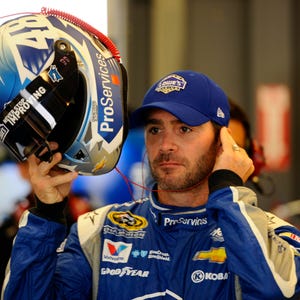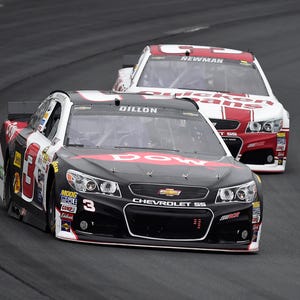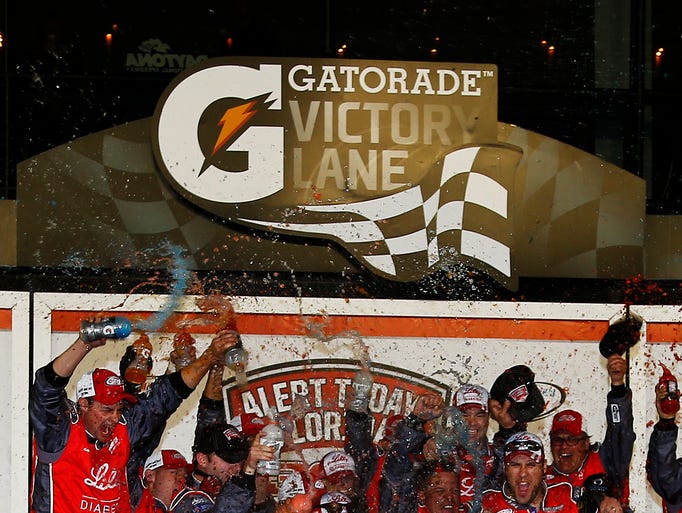Drivers not ready to embrace NASCAR’s new Brickyard package – USA TODAY
LOUDON, N.H. — Aerodynamics changes instituted by NASCAR at Kentucky Speedway for the July 11 event were well-received after what was widely deemed one of the most entertaining races of the Sprint Cup season.
Another adjustment this weekend at Indianapolis Motor Speedway may be less effective in refreshing one of the major events of the NASCAR season, however. A tricky old venue and the brutish traits of stock cars, four-time Brickyard 400-winner Jimmie Johnson told USA TODAY Sports, may make it unlikely NASCAR can replicate the type of show open wheel cars stage on the relatively flat, 2.5-mile expanse.
“My opinion, without turning a lap, is that I don’t think we’re going to get the passing that NASCAR is hopeful for at Indy,” Johnson said. “I don’t see the field being any closer together, from what I’m told.”
Johnson said that from the information he has gleaned about the high-drag, high-downforce package, cars running alone in race trim will able to be run almost at full throttle at the Brickyard, insufficient to bunch the field and produce the drafting and slingshot passing opportunities espoused as a goal by series chairman Brian France. Track characteristics at the higher-banked, multiple-lane, two-mile Michigan International Speedway — which will use the same package as Indianapolis — are more likely to produce the desired result, Johnson said.
Concocting an aerodynamics package and a race car for Indianapolis is a difficult given the low 12-degree banking in corners, long straightaways and the narrow confines of a track built more than a century ago to test the nascent automobile. Modern Indy cars are difficult enough to prepare despite the higher downforce levels and lighter weight that make them more nimble than heavier stock cars. The Brickyard 400, therefore, rarely produces the type of close-quarters dicing and exhilarating finishes such as that staged between Indianapolis 500 winner Juan Pablo Montoya this May after a pitched fight to the finish with Will Power and Scott Dixon. A nine-inch spoiler gouging a larger air wake is being used by NASCAR as a first attempt at spicing the product. Stock cars benefit more from an aerodynamic push than the so-called “tow” that allows IndyCar series cars to draft at higher speeds.
So until they turn a lap, drivers guess, and hope.
“It could turn out to be spectacular, but I don’t think you know until you see it,” driver Carl Edwards said.
Johnson said Sprint Cup racing at Indianapolis would benefit from a transmission with extremely close gear box ratios that would allow drivers to downshift in corners without “upsetting the car, and then being able to grab two or three more gears up to take advantage of a run, stay in the power band and make passes.”
But without that complicated fix, Johnson said, Sprint Cup would need to remove, he estimates, at least 200 horsepower or add an extreme amount of additional downforce to attain “easy-flat” full-throttle racing and the scenario France envisions at Indianapolis.
It became apparent that this is all far from a finished when despite the rousing success at the 1.5-mile Kentucky track in a lower-downforce package, France said in a SiriusXM interview that he seeks more drafting and pack racing.
Drivers have lauded NASCAR’s earnestness in attempting to enliven the racing at various types of tracks with unique aerodynamic adjustments, making cars more difficult to handle. But the term “pack racing” and all the negativity that entails — heightened proximity and mayhem potential, as is a common theme on restrictor-plate tracks at Daytona International Speedway and Talladega Superspeedway — disconcerts many for various reasons. Veterans, Johnson said, want cars with more horsepower and less downforce and not to engage in “video game” racing that would be the norm if France’s pack racing vision is attained.
“As a driver, running wide open, easy-flat is the last thing I want to see,” Johnson said. “It takes the finesse and the skills I’ve learned since I was five years old racing, it takes those out of the equation. So I am not in favor of it. I like the Kentucky package, I like off-throttle time, I like the car slipping and sliding. But at the same time, I want a job, so we do what we have to do.”
Edwards said NASCAR should “should stay as far away from (pack racing) at the other tracks as possible. That’s my opinion.”
“The way a race looks and the way a race is are two completely different things,” Edwards said. “You can take and just leave the pace car out there and we can all sit in line nose to tail, that’s a pretty good picture, but it’s not a race. A race to me, a stock car race is guys taking cars that are not meant to go that fast, they’re not aerodynamic devices, they’re just cars that go race on pavement and they can race close and guys have to manage the cars because they’re heavy and they’re powerful. That’s a race.
“I think it’s a very fine line that NASCAR has to walk on between putting on the best competition, which is one thing and putting on the show that looks the best, which is another. I think there’s less substance there.”
Team owner Roger Penske, whose drivers won the Daytona 500 and Indianapolis 500s this year and seeks his first Brickyard 400 title, wonders if the substance of France’s plan is being misconstrued.
“Maybe it was his terminology,” Penske said of France invoking pack racing. “He wants to see guys be able to pass and not one guy get out front and lead it all. I guess that’s what he wants. And I guess if you’re in the back you want to be able to pass. So, there’s some pluses to it. I’m sure there are some minuses.”
This weekend the minus might entail the fact that science simply precludes NASCAR officials from having everything it wants at every venue, no matter its prestige.
“I think Indy is the best race for the IndyCar series,” Johnson said. “When they get on mile-and-a-halfs, I don’t think the racing is as good as Indy, where the potential there is opposite for us at Indy.”
Follow James on Twitter @brantjames
PHOTOS: 2015 Sprint Cup race winners








